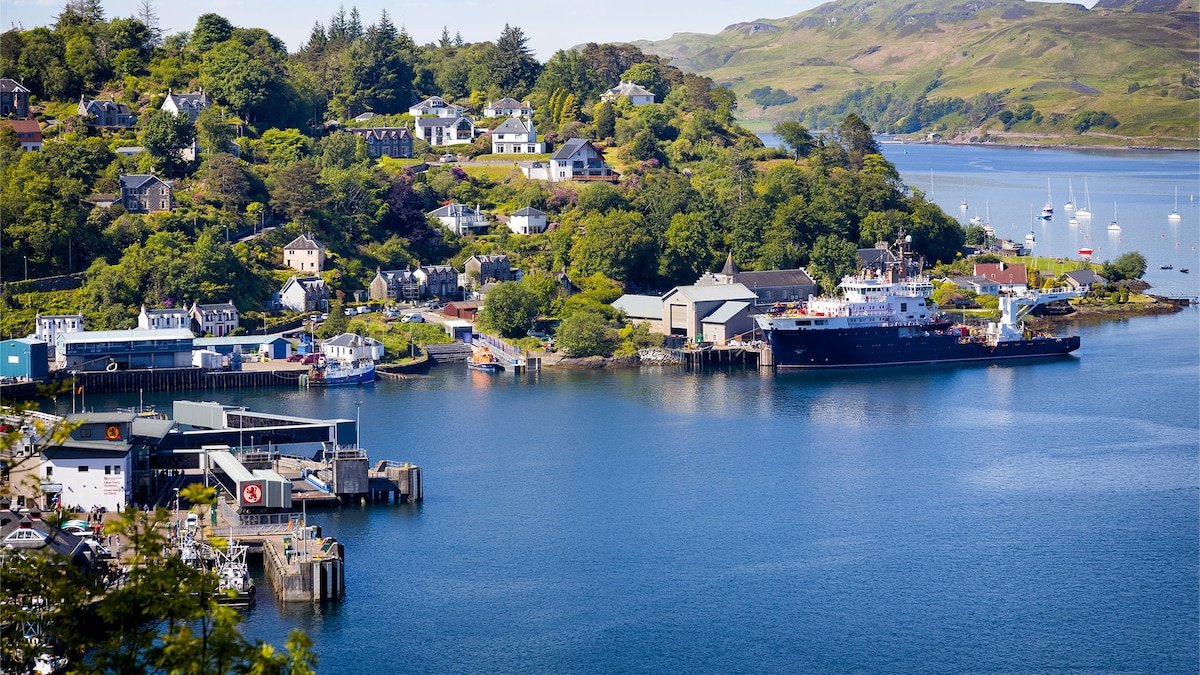West of Glasgow, the peninsula of Argyll stretches towards its cluster of neighbouring isles, which fan out in all their marvellous diversity. Although small on the map, this part of Scotland has more than 2,300 miles of coast — about as much as South Africa — and 23 inhabited islands, each with their own character. After exploring the mainland’s castles and lochs, head to the fishing port of Oban to fill up on lobsters and mussels. From there, you can depart for an island adventure where you might set forth in a sea kayak, get a taste of the region’s 24 whisky and gin distilleries, or scale a mighty Munro — a mountain that towers above 3,000 ft. From sipping scotch fireside, to navigating wild Atlantic coastlines, here’s how to explore Scotland’s rugged western shores.
What’s Argyll & the Isles known for?
Argyll & the Isles is where Scotland’s complex history comes alive. Learn about grisly, Victorian-era justice at Inveraray Jail, or take a pilgrimage to the cradle of Scottish Christianity at Iona Abbey, founded by St Columba in the sixth century. Travel yet further back in time at Kilmartin Glen: Scotland’s most important Neolithic and Bronze Age site, with more than 350 monuments scattered over heather-tufted hills.
The ferocious inter-clan wars of Scotland’s past have drawn many curious visitors here, to the seat of Clan Campbell — once one of Scotland’s largest and most powerful clans. The Campbells’ ancestral home is at Inveraray Castle, where the current chief still resides; visit the ornate State Dining Room and the Armoury Hall, hung with muskets, polearms and axes.

A large colony of puffins occupy Staffa, where they nest on the cliffs of the uninhabited island between April and early August.
Photography by PIERRE LONGNUS, GETTY

Argyll and the Isles incorporates a number of Scotland’s whisky regions within its borders, including the Highland distillery of Oban.
Photograph by WILD ABOUT ARGYLL
Argyll & the Isles is a place of pilgrimage for whisky lovers, with four (Highlands, Islay, Campbeltown and Islands) of Scotland’s six whisky regions represented. Distilleries here are known for big, bold drams that incorporate peat smoke, maritime and medicinal flavours. Islay alone has 10 distilleries — the newest is Port Ellen, which reopened in 2024 after a hiatus of 41 years.
The region’s coastal and mountain scenery draws adventurers of all types. Mountain climbers on a mission to ‘bag’ (summit) Scotland’s Munros have many to choose from, including the perennially popular Ben Vorlich. You’ll find big waves for surfing at Tiree and Kintyre, and a sheltered, sandy beach for paddleboarding at Ganavan Sands just north of the town of Oban.
What are the main attractions?
Argyll comprises a significant portion of Loch Lomond and the Trossachs National Park. The conservation village of Luss — the ancestral home of Clan Colquhoun — is the main launch point for cruises of the loch’s 37 islands. On returning, stroll the pine-lined beach or have dinner and a dram in a lochside restaurant.
The Argyll Sea Kayak Trail starts at Ganavan and weaves around 93 miles of dramatic coastline, split into nine sections. The final one is one of the most scenic, starting at Dunoon and dipping into three Clyde Sea Lochs — Holy Loch, Loch Long and Gare Loch — before ending at Helensburgh. On the way, you might spot seabirds, seals and even northern bottlenose whales.

The town of Oban acts as a gateway to many of Scotland’s islands, with ferries departing to Mull, Coll and a number of other ports around the coast.
Photograph by EWG3D, GETTY
Oban and the Isle of Mull are a popular twin destination getaway, due to frequent ferries connecting the two. On Mull, potter around the famed technicolour homes of Tobermory and visit Tobermory Distillery, one of Scotland’s oldest. Back on the mainland tuck in to fresh crab at Oban Seafood Hut or oysters and seared scallops at Waterfront Fishouse. Around a half hour drive north of Oban, paddleboarders can relish the unique experience of paddling around Castle Stalker, marooned out in Loch Laich.
Coll and Tiree are the region’s westernmost islands. Coll is truly remote; a designated Dark Sky Community, its nearest streetlight is 20 miles away. The island’s shores also host an RSPB reserve, home to corncrakes and hen harriers. From Tiree, boats depart for puffin- and dolphin-watching tours — or to Fingal’s Cave on the uninhabited Isle of Staffa, where the basalt cathedral was immortalised by the composer Mendelssohn.
When’s the best time to visit?
Spring and summer are well suited to wildlife-watching adventures, with peak nesting season from May to July — and excellent conditions for whale and dolphin spotting from June to September.

Highland games take place across Argyll & the Isles in the summer months including in Cowal, Inverary, Luss and Bute.
Photography by THE COWAL GATHERING

Castle Stalker, built by Clan Stewart in the 15th century, appeared in the film ‘Monty Python and the Holy Grail’.
Photography by IMAGEBROKER/MARKUS KELLE, GETTY
Every summer, around 23,000 people descend on Dunoon for the Cowal Highland Gathering, Argyll’s biggest highland games. Watch international stars competing at the World Highland Dancing Championship, brawny athletes tossing the caber (a large wooden pole) and kilted pipers blasting out traditional tunes like Highland Laddie.
September to March is ideal for experienced surfers, who head to Tiree to tackle the big swells that break on the island at this time of year.
With long nights and mostly clear skies, winter is perfect for stargazing — especially at the Dark Sky Reserve on Coll. If you’re lucky, you might even see the aurora borealis. Burns Night takes place every 25 January in honour of Scotland’s national poet, Robert Burns. Many restaurants and pubs will arrange live music or poetry readings, plus a Burns supper of haggis, neeps (swede) and tatties (mashed potatoes). This may be followed by an evening of lively traditional dancing with a ceilidh, the ideal way to round off the celebrations.
This paid content article was created for Wild About Argyll. It does not necessarily reflect the views of National Geographic, National Geographic Traveller (UK) or their editorial staffs.
To subscribe to National Geographic Traveller (UK) magazine click here. (Available in select countries only).










